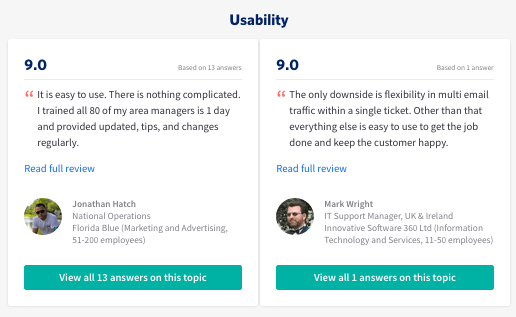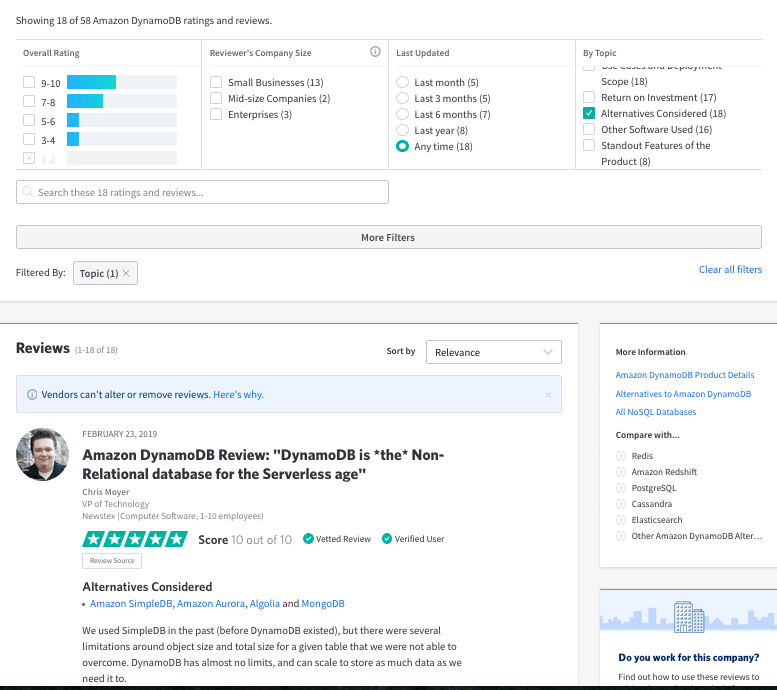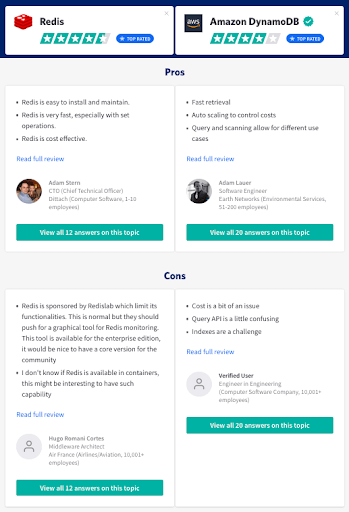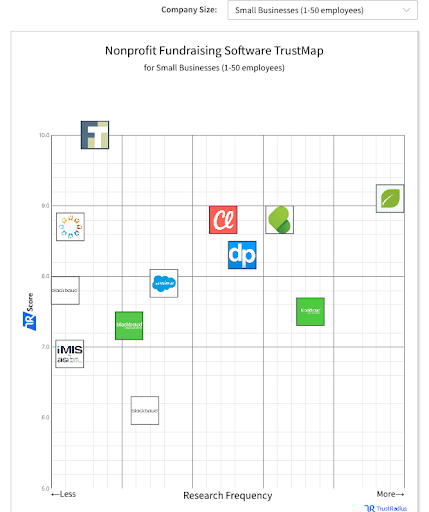For users looking to compare new and existing software options for their organization, reviews are your secret weapon. Real, unbiased reviews help highlight how features translate to user experience in a way not found on a vendor website. They will help you get answers, set expectations, and save time.
TrustRadius is the most trustworthy site for user reviews of business software. And the top reason buyers visit TrustRadius is to compare products!
You can use TrustRadius to easily compare software products. The 3 comparison methods outlined below are
1. Create a head-to-head software comparison
TrustRadius offers a comparison tool you can use to look at two or three products side by side. See how product capabilities and functionality stack up. Use quantitative data (feature and attribute ratings) to directly compare important product dimensions, apples to apples. For instance, you can combine qualitative insights with factors like support, performance, and usability when comparing the software options you are researching.
The TrustRadius comparison template is designed to provide the best software comparison information in a clean, simple user interface.
There are three ways to create a comparison:
1. On the main navigation bar at the top of the site, go to Reviews > Compare Products, then select the products you want to compare.

For example, maybe you want to compare Help Desk software. If you know Zendesk, you can browse for other products in that same category to compare.
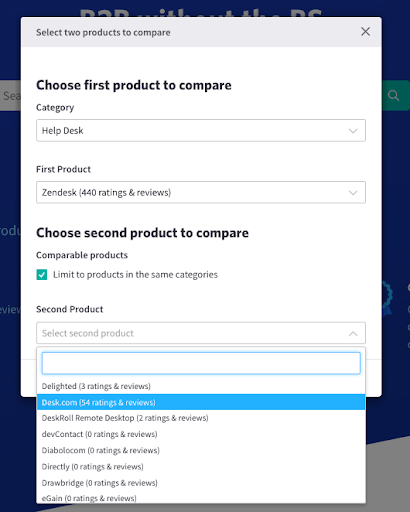
2) On a product listing, you can use the sidebar on the right-hand side labeled “Compare with…” to jump to the top six most common comparisons. If you were on the Zendesk product page, for example, you could quickly create a comparison to ServiceNow.
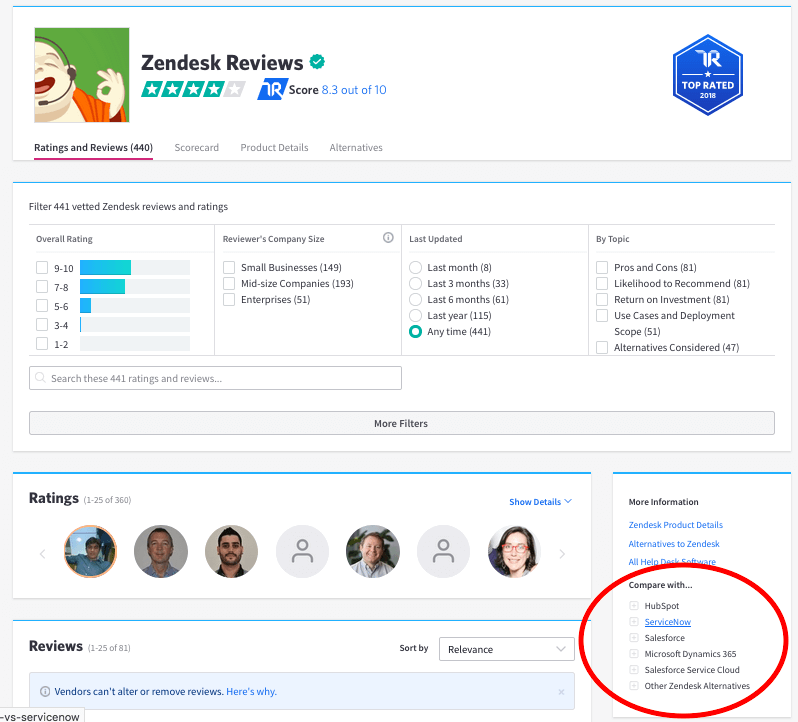
3) On a category page–let’s use Help Desk Software again for this example–you can get to the comparison tool by clicking the link under the product description in the list of all Help Desk Products. (Note that some vendors, like ConnectWise here, have a direct link to their product website rather than a comparison link on their category page result.)
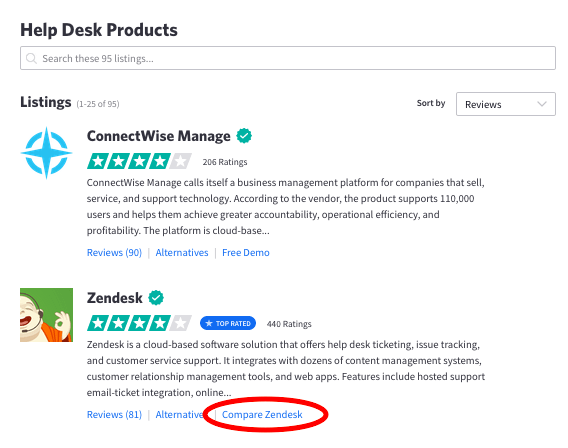
Any of these three modes of navigation will take you to the same place–our dynamic comparison tool! You can compare up to three products at a time. Use the menu on the right-hand side to add products to the comparison. Use the little X at the top of the product card to remove a product from the comparison. The menu on the left-hand side will let you jump from topic to topic within the comparison.
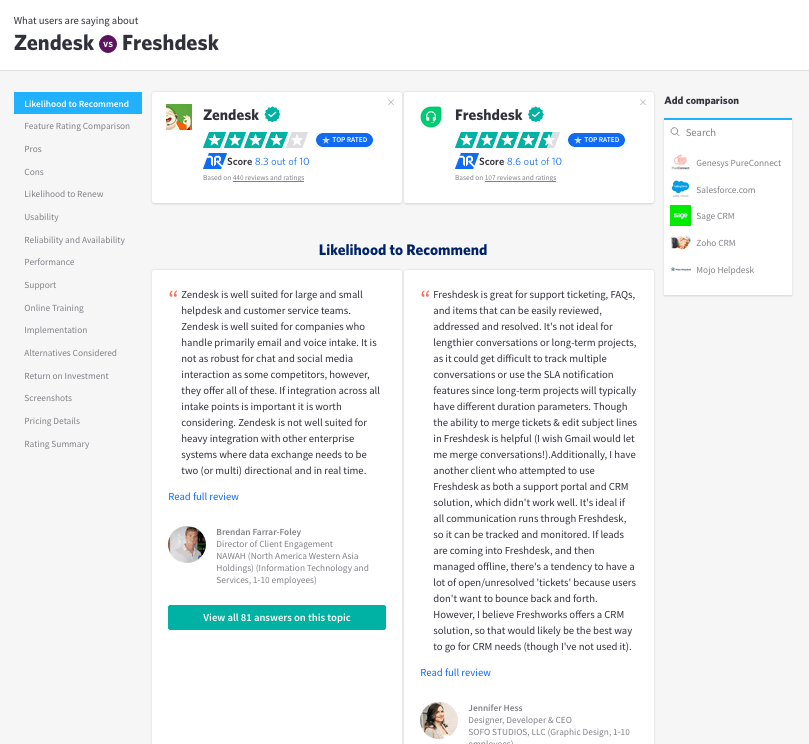
Feature Rating Comparison
Features are defined at the category level. They’re not exhaustive, but cover the main capabilities provided by most products in the space. Feature ratings can help you compare functionality offered by multiple products, to see which offerings are stronger for the features you care most about. These ratings are collected from verified users during the review authoring process.
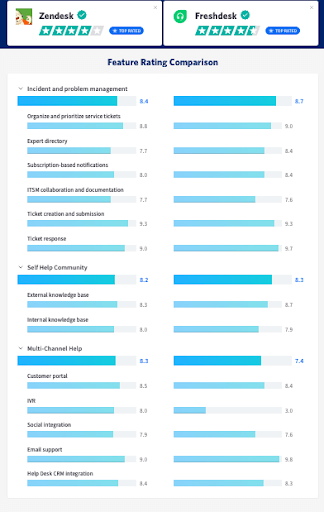 Attribute Ratings
Attribute Ratings
You will also be able to compare attribute ratings from the product scorecards in one place with the comparison tool. Attributes include things like Usability, Reliability and Availability, Performance, Support, Online Training, Implementation, etc. These are topics that are not tied to a specific category, but are relatively standard (and important!) considerations across all software products. You’ll notice that attributes include both a quantitative and qualitative component. We ask users to rate the attribute, as well as provide their rationale, as part of their review.
What is Direct Comparison Best for?
This type of reviewer-driven comparison offers information in clear, real-world terms by verified software users. You can compare two products to find the option with the highest ratings for the traits that are most important to you. In fact, you can compare 3 or more software as well.
Comparisons based on in-depth reviewer feedback allow for real-time analytics of hundreds or thousands of data points. With this, you get a sense of how the whole user marketplace feels about aspects of the software.
2. Read between the lines
Quantitative metrics are easy to compare, but they don’t tell the full story. Rich qualitative data can help you put software features and attributes in context. Along with comparing ratings, reading reviewers’ qualitative responses–to the Alternatives Considered, Use Case, and Pros & Cons questions in particular–will give you a clearer picture of how products compare and why.
You can read review answers on the comparison pages described above, or by researching products one at a time and using the Topic filter to hone in on specific insights. For example, if you want to compare Redis vs. Amazon Dynamo DB, you can use the TrustRadius dynamic comparison tool to get a snapshot with review excerpts. Or, you can do diligence on the Redis listing and then the Amazon Dynamo DB listing, filtering to read all responses about Alternatives Considered.
Alternatives Considered
When someone writes a review on TrustRadius, we ask them point-blank to weigh in on how the product they’re reviewing stacks up against other similar products they used or evaluated. Their answers can give you direct insight into the biggest differences they’ve noticed, from a practical perspective you can identify with. They’re the Cliff Notes of comparisons.
Use Case
We also ask reviewers to describe how they’re using the product–in term of the scale, and the problems they’re solving. This may sound like a basic topic, but it is actually one of the most helpful for quickly comparing software. If you have your own potential use case in mind, skimming through the Use Case answers for a couple of different products will give you an organic sense of how they are used differently, and which product(s) might align best with the purpose you had in mind. Unlike vendor marketing materials, which tend to have a lot of fluff and use all the same buzzwords, reviewers cut to the chase with descriptions of what the product does that you can actually relate to.
Pros & Cons
On TrustRadius, reviewers are required to list both strengths and areas for improvement (because balanced feedback is considered and trustworthy). We display pros and cons in a bulleted list format that is easy to skim. Read through the pros and cons for the products you want to compare, scan for common mentions, and get a feel for how their strengths and areas for improvement are different.
What are Qualitative reviews best for?
These comparisons allow you to find exactly what users like and dislike, and let you hear more about it. TrustRadius reviewers spend a significant amount of time adding qualitative context behind their ratings. The ability to compare software by use case lets you see where a prospective tool has and hasn’t succeeded in the past. Comparison websites often focus on features and rankings.
TrustRadius’s qualitative information outlines the direct impact of software on a user’s organization. Read between the lines to see where products shine at a more individual level. Use this when informing your buying decision, free trial, or subscription renewal.
3. Determine which products are used by people like you
There’s no use buying a highly rated software product if it doesn’t meet your specific needs. And you don’t want to sign on with a product that isn’t headed in the right direction for your business.
Which options are better suited to your use case today? Which options are more likely to add new features that will help you in the future? One way to prioritize is to find products geared towards people like you, and companies like yours, in terms of size and industry. TrustRadius offers two tools to help you determine this: TrustMaps (for a category-level view) and review filters (for a product-level view).
TrustMaps
TrustMaps are a good way to compare products when you’re still in the early stages of figuring out which products you should look into. You can filter TrustMaps by company size, to get a birds-eye view of the products in a category that are relevant to companies like yours.
Step 1: Start with a search for the type of product you seek (for example, “Nonprofit Fundraising Software”).
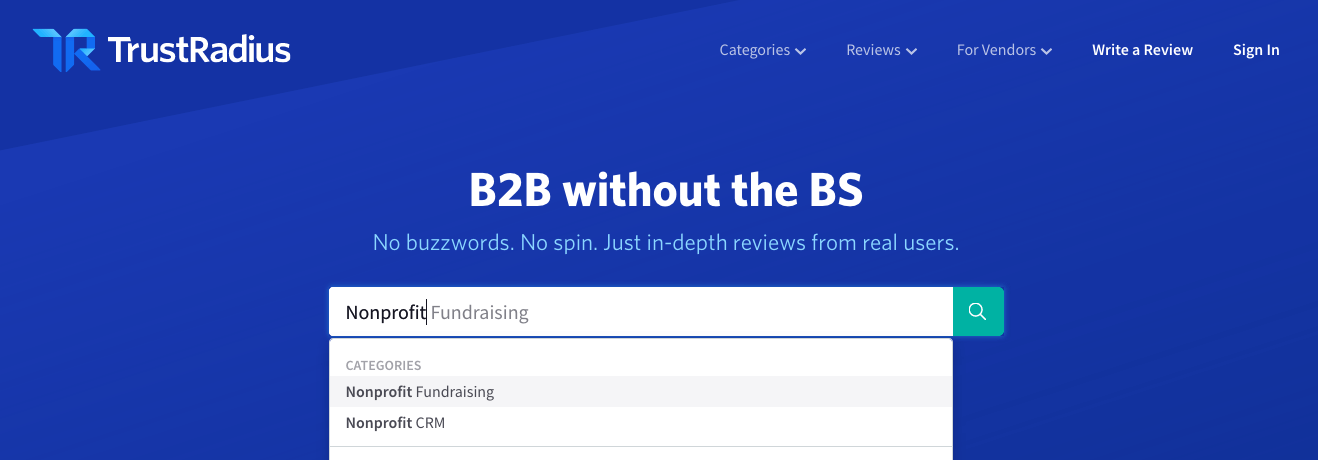 Step 2: On the category page, use the dropdown menu above the TrustMap (for example, under “Best Nonprofit Fundraising Software”) to select your company size.
Step 2: On the category page, use the dropdown menu above the TrustMap (for example, under “Best Nonprofit Fundraising Software”) to select your company size.
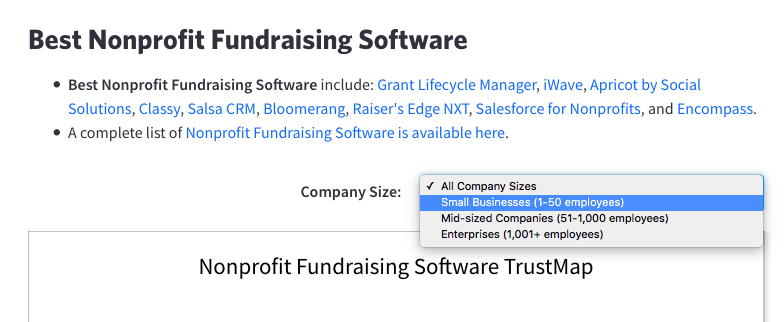
Step 3: See how the products used by other companies of your size compare, based on satisfaction and relevance. The trScore (i.e. star rating) on the y-axis tells you how current users feel about each product, while the research frequency (i.e. pageviews) on the x-axis tells you how often other buyers consider them. This gives you a way to visualize what other people like you think about these products relative to one another.
Customer base breakdown by product
When you already know which products you’re interested in, you can use review filters to compare their customer bases. The advanced filters on a product page will show you company size distribution and industry breakdown. Reviewer demographics tend to be a good proxy for a product’s customer base. (The more reviews, and the more recent they are, the better this trick works). You can check the company size and industry breakdown of one product you’re considering versus other products on your list. You may be able to determine that some products are a stronger match than others.
Step 1: Search for a product name and click on the listing (for example, “Marketo”).
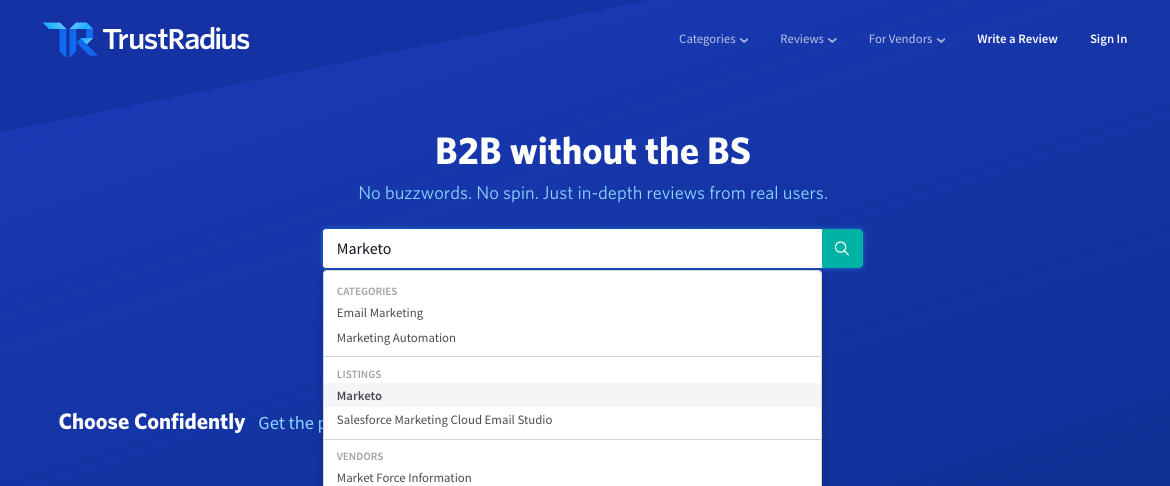
Step 2: On the product listing, find the filters for “Reviewer’s Company Size” and “Industry.” (You will have to click on “More filters” to see Industry.)

Step 3: Check to see if there is there solid representation of your industry and company size. Do you look like the target customer for this product, clearly its focus? Or will you be on the fringe, a new type of customer for this product? (For example, if you work at a large hospital, you’ll see that Marketo’s filters show feedback from 394 Enterprises and 29 Hospital & Health Care organizations.)
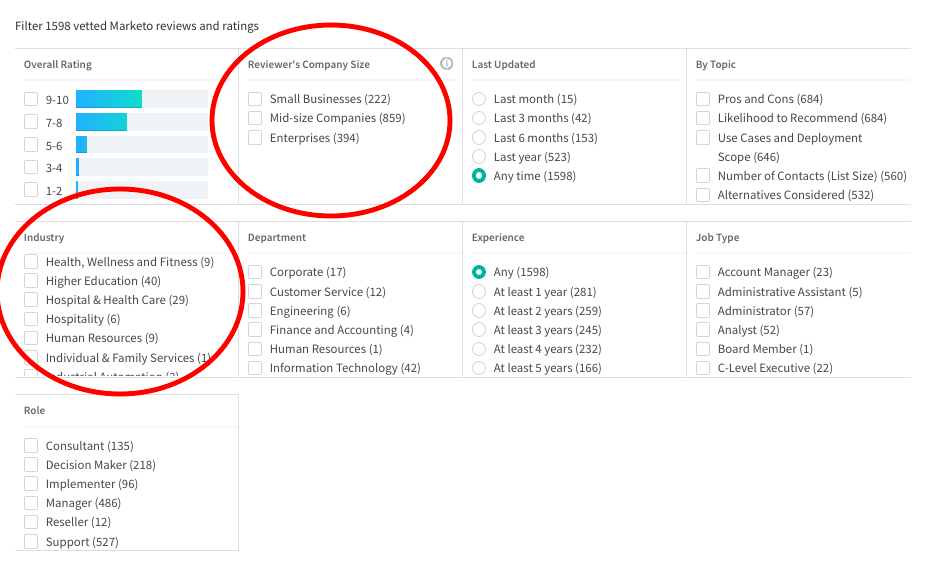
Step 4: Search for another product, and check to see how well your industry and company size are represented among its reviewer base. Compare that with your previous product. Of course, customer base breakdown is only one factor to consider among many. But if you need a tie-breaker between software products that seem functionally similar and have similar pricing, you may feel more comfortable with products that are proven to work for others like you.
How does User information Help Software Comparison?
Review sites are, at their core, a way to explore other users ’opinions and experiences with a software product. By sorting the reviews by user information, you can hear from people who are going to use the product in the same way you are. Outside of the software purchasing process, we do this all the time. We ask friends their opinions when they have already used a good or service we are considering. TrustRadius connects you to the global network of software comparison shoppers who have already been where you are. Use this information to breakdown features and software attributes in the way you intend to make use of them.
Good Luck with Your Software Comparisons!
These are just three suggestions for approaches to take when comparing software. We hope you find them helpful. Most buyers we talk to choose to organize their research in a spreadsheet or a slide presentation format. Feel free to use data you find on TrustRadius as you compile your rationale of how software products compare. You can even link directly to comparison pages for backup!
If you are looking at an in-depth comparison of common products in video format, we have you covered. Our youtube channel includes popular software comparisons. Check out the playlist below!
If you have used TrustRadius to compare products and you prefer to take a different approach, please reach out to let us know at research@trustradius.com. We would love to add your suggestions to this article.
Need Any Technology Assistance? Call Pursho @ 0731-6725516


